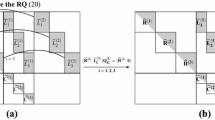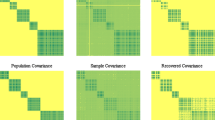Abstract
Covariance-based DoA estimation (CB-DoA) algorithms represent lower computational complexity alternatives to the traditional ESPRIT approach. This paper investigates CB-DoA using Krylov-subspace techniques (including Arnoldi’s and Lanczos’ updates) with respect to the resulting computational cost and estimation error performance. The proposed modifications also allow an automatic estimation of the number of sources. Computational analyses performed for the resulting CB-DoA algorithm indicate cost savings above \(60\,\%\) in comparison with the standard CB-DoA implementation, which already represents a \(20\,\%\) improvement upon its ESPRIT counterpart, at an equivalent mean squared error level, as verified in numerical simulations.









Similar content being viewed by others
References
K. Almidfa, G.V. Tsoulos, A. Nix, Performance analysis of ESPRIT, TLS-ESPRIT and unitary ESPRIT algorithms for DoA estimation in a WCDMA mobile system, in Proceedings of International Conference on 3G Mobile Communication Technologies (2000), pp. 200–203
W.E. Arnoldi, The principle of minimized iterations in the solution of the matrix eigenvalue problem. Q. Appl. Math. 9, 17–29 (1951)
S. Chouvardas, K. Slavakis, S. Theodoridis, Trading off complexity with communication costs in distributed adaptive learning via Krylov subspaces for dimensionality reduction. IEEE J. Sel. Top. Signal Process. 7(2), 257–273 (2013)
T.N. Ferreira, S.L. Netto, P.S.R. Diniz, Direction-of-arrival estimation using a low-complexity covariance approach. IEEE Trans. Aerosp. Electron. Syst. 48(3), 1924–1934 (2012)
T.N. Ferreira, S.L. Netto, P.S.R. Diniz, Covariance-based direction-of-arrival estimation with real structures. IEEE Signal Process. Lett. 15, 757–760 (2008)
T.N. Ferreira, S.L. Netto, P.S.R. Diniz, Low complexity covariance-based DoA estimation algorithm, in Proceedings of the 15th European Signal Processing Conference, Poznan, Poland (2007), pp. 100–104
L.C. Godara, Applications of antenna arrays to mobile communications I: Performance improvement, feasibility and system considerations. Proc. IEEE 85(7), 1031–1060 (1997)
G.H. Golub, C.F. van Loan, Matrix Computations, 3rd edn. (Johns Hopkins University Press, Baltimore, 1996)
R. Grover, D.A. Pados, M.J. Medley, Subspace direction finding with an auxiliary-vector basis. IEEE Trans. Signal Process. 55(2), 758–763 (2007)
M. Haardt, J.A. Nossek, Unitary ESPRIT: how to obtain increased estimation accuracy with a reduced computational burden. IEEE Trans. Signal Process. 43(5), 1232–1242 (1995)
G. Hu, T. Kailath, Fast subspace decomposition. IEEE Trans. Signal Process. 42(3), 539–551 (1994)
S. Qiao, G. Liu, W. Xu, Block Lanczos tridiagonalization of complex symmetric matrices, in Advanced Signal Processing Algorithms, Architectures, and Implementations XV, Proceedings of the SPIE, vol. 5910 ed. by F.T. Luk (2005), pp. 285–295
R. Roy, T. Kailath, ESPRIT—estimation of parameters via rotational invariance techniques. IEEE Trans. Acoust. Speech Signal Process. 37(7), 984–995 (1989)
R.O. Schmidt, Multiple emitter location and signal parameter estimation. IEEE Trans. Antennas Propag. AP–34(3), 276–280 (1986)
J. Steinwandt, R.C. de Lamare, M. Haardt, Beamspace direction finding based on the conjugate gradient and the auxiliary vector filtering algorithms. Signal Process. 93, 641–651 (2012)
T. Tazeen, A. Kansal, Low-complexity equalization of OFDM systems using Krylov subspace methods over doubly selective channels. Int. J. Emerg. Res. Manag. Technol. 3(8), 64–70 (2014)
L. Tong, G. Xu, T. Kailath, Blind identification and equalization based on second-order statistics: a time-domain approach. IEEE Trans. Inf. Theory 40(2), 340–349 (1994)
L.N. Trefethen, D. Bau III, Numerical Linear Algebra (SIAM, Philadelphia, 1997)
M. Wax, T. Kailath, Detection of signals by information theoretic criteria. IEEE Trans. Acoust. Speech Signal Process. 33(2), 387–392 (1985)
Acknowledgments
The authors thank the Brazilian National Council for Research and Development (CNPq), the Brazilian Ministry of Education’s CAPES, and the State of Rio de Janeiro Funding Support for Research (FAPERJ).
Author information
Authors and Affiliations
Corresponding author
Rights and permissions
About this article
Cite this article
Ferreira, T.N., de Campos, M.L.R. & Netto, S.L. Covariance-Based DoA Estimation in a Krylov Subspace. Circuits Syst Signal Process 34, 2363–2379 (2015). https://doi.org/10.1007/s00034-014-9966-3
Received:
Revised:
Accepted:
Published:
Issue Date:
DOI: https://doi.org/10.1007/s00034-014-9966-3




